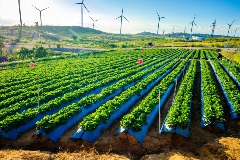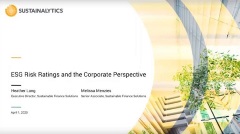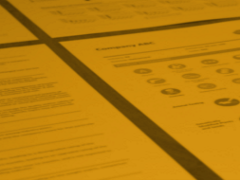Investing in Companies with Positive Momentum in ESG Risk and Economic Moat Development
In Sustainalytics’ paper, Combining ESG Risk and Economic Moat,[i] we examined the effect of combining the two metrics, showcasing the benefits of higher returns and lower downside risk. More specifically, investing in companies with negligible/low ESG risk and wide economic moats was advantageous for creating alpha over the past four years.
Five Commonly Asked Questions About Sustainalytics’ Approach to Impact
We launched our new Impact Metrics product to support investors’ growing need for more robust data that can be used to demonstrate how ESG-focused strategies can deliver real-world social and environmental outcomes. Since the launch, I have connected with many enthusiastic institutional investors eager to make sense of the rapidly evolving world of impact, excited to dive into impact data, and cautiously optimistic about supporting their clients’ Sustainable Development Goal (SDG) and impact needs.
Corporate ESG in Focus: An Overview of ESG and its Impact on Companies
With climate change and social justice concerns increasingly dominating headlines, environmental, social, and corporate governance (ESG) factors are no longer treated as trivial issues confined to a company’s CSR department. ESG is now central to a company’s financial performance and reputation.
10 for 2021: Investing in the Circular Economy
This report aims to support investors interested in gauging environmental, social and governance (ESG) risks and opportunities in the global food value chain. We survey key subindustries – from agrochemicals, agriculture and aquaculture to packaged food, food retail and restaurants – in search of solutions that may support the principles of the circular economy (CE). These principles include minimizing waste and pollution, extending the use-phase of products and ecosystem regeneration. Some of the key insights found in the report are:
Lessons Learned from 926 Engagement Meetings in Emerging Markets
When Sustainalytics (GES[1]) initiated the Emerging Markets (EM) Engagement program as a pilot project in 2009, the scale, scope and impact were undetermined factors. Based on the successful execution of the program methodology in the African and Middle Eastern regions during the pilot stage, the full program launched in 2010 to cover all major emerging markets. After the project close in July 2020, the program accounts for 926 meetings with companies in emerging markets.
Is Natural Gas a Cleaner Energy Solution?
While Oil and Gas (O&G) operations are responsible for roughly 15 percent of global energy-related GHG emissions, some energy companies have pledged the role of natural gas (NG) as a transitional fuel. At the same time, NG energy use is increasing globally, and shale-gas extraction is booming at an unprecedented rate. One factor that is often overlooked is the methane emissions across the NG value chain.
Combining ESG Risk and Economic Moat
In this report, we look at the potential synergies between Sustainalytics’ ESG Risk Ratings and Morningstar’s Economic Moat Rating. As a part of our research, we constructed a back-testable investment strategy and portfolio by segmenting stocks with low ESG risk and a wide moat. While both metrics worked independently, they performed exceptionally well in combination.
Corporate ESG Ratings: How businesses are leveraging their ESG Risk Ratings
Good environmental, social and governance (ESG) performance is not just about meeting investor demands. From revenue generation and raising capital to talent acquisition and employee retention, strong corporate ESG performance can influence key aspects of a company’s operations.
Corporates leverage ESG Peer Performance Insights as a risk management tool
As the social and economic challenges of 2020 continue to unfold and markets remain in flux, the resilience of Environmental, Social, and Governance (ESG) investing marks a silver lining. In the context of today’s bear market, investors are demonstrating their preference for sustainable funds over traditional ones, with Q1 2020 seeing a global influx of USD 45.6bn, compared to outflows of USD 384.7bn for the overall fund universe. Europe has continued to account for the majority of this inflow into sustainable funds, while the U.S. has picked up pace with a 100% y-o-y increase, the highest regionally. Furthermore, Morningstar reported that 89%, or 51 out of 57, of its sustainable indices outperformed their market peers in Q1 2020. For ESG practitioners, this may not come as a surprise as experience has shown that companies with robust corporate cultures and sustainable business practices are best-positioned for long term resilience and growth, leading to stickiness of ESG investments.
Corporate ESG Ratings in Latin America: Use Cases for Companies and Banks | Webinar
To take advantage of the demand for ESG-related disclosure and communicate their sustainability achievements to internal and external stakeholders, many forward-looking companies are leveraging ESG information in their capital raising activities and marketing efforts.
ESG Risk Ratings and the Corporate Perspective
In this webinar, Sustainalytics’ Sustainable Finance Solutions team shared insights from our recently published Sustainable Finance Guide. They also discussed our ESG Risk Ratings, how it is being utilized for sustainable finance and beyond, and how companies are leveraging their ESG Ratings for capital raising activities, marketing and communications efforts and internal benchmarking processes.
ESG Risk Ratings Licence
An ESG Risk Ratings Licence from Sustainalytics, allows your company to use Sustainalytics’ ESG Risk Rating for various internal and external corporate purposes. As awareness of the materiality of environmental, social and governance (ESG) factors has grown, so too has the demand for new uses of ESG data and information to be disclosed beyond just the investor community.
Introduction to Sustainability-Linked Loans and ESG Ratings
Sustainable finance and green lending are on the rise as more borrowers and lenders recognize the potential benefits of green and sustainability-linked loan products for their businesses. According to the Loan Markets Association (LMA), sustainability linked loans are a "dynamic and innovative product that enables lenders to incentivize improvements in the borrower's sustainability profile.” Sustainability linked loans align the loan terms to the borrower's performance against pre-determined sustainability performance targets such as a company’s ESG rating. Learn more about ESG Ratings










.tmb-small.jpg?Culture=en&sfvrsn=8465a62d_2)





.tmb-small.jpg?Culture=en&sfvrsn=edbba807_2)
ee43428f-bcdf-4965-bdf5-d425e447dd71.tmb-small.jpg?Culture=en&sfvrsn=f87532da_2)


